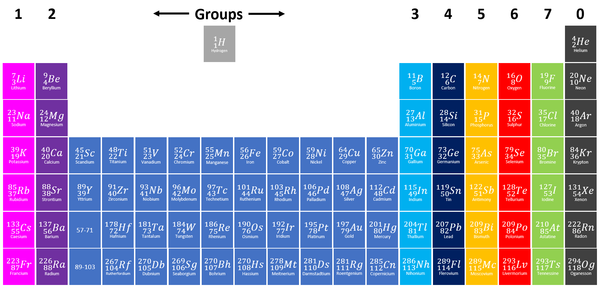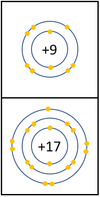Difference between revisions of "Group 7"
| (10 intermediate revisions by 2 users not shown) | |||
| Line 24: | Line 24: | ||
: '''Halogens''' all [[Chemical Reaction|react]] strongly as [[Bleaching Agent|bleaching agents]]. | : '''Halogens''' all [[Chemical Reaction|react]] strongly as [[Bleaching Agent|bleaching agents]]. | ||
: '''Halogens''' all produce [[acid]]s when combined with [[Hydrogen]]. | : '''Halogens''' all produce [[acid]]s when combined with [[Hydrogen]]. | ||
| − | : '''Halogens''' are [[ | + | : '''Halogens''' are [[toxic]] to [[bacteria]] and are used in [[disinfectant]]s. |
| + | {| class="wikitable" | ||
| + | |- | ||
| + | |[[File:Group7ElectronShells.png|center|100px]] | ||
| + | |[[File:Group7ElectronShielding.png|center|100px]] | ||
| + | | style="height:20px; width:400px; text-align:left;" |In a [[Chemical Reaction|chemical reaction]] an extra [[electron]] is added to the [[Outer Shell|outer shell]]. | ||
| + | |||
| + | The [[reactivity]] decreases as you go down the group because: | ||
| + | *The outer [[electron]]s are further away from the [[Atomic Nucleus|nucleus]] with each additional [[Electron Orbital|electron shell]] making the [[force]] of [[attract]]ion weaker. This makes it less able to gain an extra [[electron]]. | ||
| + | *Even though the [[Electrical Charge|charge]] of the [[Atomic Nucleus|nucleus]] increases the outer [[electron]]s are shielded from most of the [[Positive Charge|positive charge]] of the [[Atomic Nucleus|nucleus]] by [[electron]]s in the inner shells. | ||
| + | |} | ||
===Physical Properties=== | ===Physical Properties=== | ||
| Line 34: | Line 44: | ||
*[[Astatine]] -A dark purple [[solid]] at [[Room Temperature|room temperature]]. | *[[Astatine]] -A dark purple [[solid]] at [[Room Temperature|room temperature]]. | ||
: The [[density]], [[Melting Point|melting point]] and [[Boiling Point|boiling point]] all increase as you go down the [[Periodic Table]]. | : The [[density]], [[Melting Point|melting point]] and [[Boiling Point|boiling point]] all increase as you go down the [[Periodic Table]]. | ||
| + | |||
| + | ===References=== | ||
| + | ====AQA==== | ||
| + | |||
| + | :[https://www.amazon.co.uk/gp/product/1471851354/ref=as_li_tl?ie=UTF8&camp=1634&creative=6738&creativeASIN=1471851354&linkCode=as2&tag=nrjc-21&linkId=9012a0d354024419214fb3ad5ac44ba0 ''Group 7 (halogens), pages 131-4, GCSE Combined Science Trilogy 1, Hodder, AQA ''] | ||
| + | :[https://www.amazon.co.uk/gp/product/0008158762/ref=as_li_tl?ie=UTF8&camp=1634&creative=6738&creativeASIN=0008158762&linkCode=as2&tag=nrjc-21&linkId=a0fffa35b3ea49a63404f6704e0df7cc ''Group 7 (halogens), pages 44-5, 46, GCSE Chemistry; Student Book, Collins, AQA ''] | ||
| + | :[https://www.amazon.co.uk/gp/product/1782945598/ref=as_li_tl?ie=UTF8&camp=1634&creative=6738&creativeASIN=1782945598&linkCode=as2&tag=nrjc-21&linkId=ad276ad49df77ab4b40ab4fd0fe09972 ''Group 7, page 110, GCSE Combined Science; The Revision Guide, CGP, AQA ''] | ||
| + | :[https://www.amazon.co.uk/gp/product/1782945571/ref=as_li_tl?ie=UTF8&camp=1634&creative=6738&creativeASIN=1782945571&linkCode=as2&tag=nrjc-21&linkId=9e29fad914244909903e5e93f8a01d147 ''Group 7, page 25, GCSE Chemistry; The Revision Guide, CGP, AQA ''] | ||
| + | :[https://www.amazon.co.uk/gp/product/1471851346/ref=as_li_tl?ie=UTF8&camp=1634&creative=6738&creativeASIN=1471851346&linkCode=as2&tag=nrjc-21&linkId=3ac654f4b0da781c49c855a1af4c92ea ''Group 7, pages 16-18, GCSE Chemistry, Hodder, AQA ''] | ||
| + | :[https://www.amazon.co.uk/gp/product/0198359381/ref=as_li_tl?ie=UTF8&camp=1634&creative=6738&creativeASIN=0198359381&linkCode=as2&tag=nrjc-21&linkId=47c8d1ae58d8b3a5e2094cd447154558 ''Group 7, pages 28-29, 31, GCSE Chemistry; Third Edition, Oxford University Press, AQA ''] | ||
| + | :[https://www.amazon.co.uk/gp/product/1782945962/ref=as_li_tl?ie=UTF8&camp=1634&creative=6738&creativeASIN=1782945962&linkCode=as2&tag=nrjc-21&linkId=476bb5c8d1dfb5c08ac81b6d4d1c98d8 ''Group 7, pages 61-63, GCSE Chemistry, CGP, AQA ''] | ||
| + | :[https://www.amazon.co.uk/gp/product/178294639X/ref=as_li_tl?ie=UTF8&camp=1634&creative=6738&creativeASIN=178294639X&linkCode=as2&tag=nrjc-21&linkId=51599bb45a2bfaf7c1b6a978b2ca2616 ''Group 7, pages 61-63, GCSE Combined Science Trilogy; Chemistry, CGP, AQA ''] | ||
| + | :[https://www.amazon.co.uk/gp/product/1782945598/ref=as_li_tl?ie=UTF8&camp=1634&creative=6738&creativeASIN=1782945598&linkCode=as2&tag=nrjc-21&linkId=ad276ad49df77ab4b40ab4fd0fe09979 ''Halogens, page 110, GCSE Combined Science; The Revision Guide, CGP, AQA ''] | ||
| + | :[https://www.amazon.co.uk/gp/product/1471851354/ref=as_li_tl?ie=UTF8&camp=1634&creative=6738&creativeASIN=1471851354&linkCode=as2&tag=nrjc-21&linkId=9012a0d354024419214fb3ad5ac44ba0 ''Halogens, pages 131-4, GCSE Combined Science Trilogy 1, Hodder, AQA ''] | ||
| + | :[https://www.amazon.co.uk/gp/product/1471851346/ref=as_li_tl?ie=UTF8&camp=1634&creative=6738&creativeASIN=1471851346&linkCode=as2&tag=nrjc-21&linkId=3ac654f4b0da781c49c855a1af4c92ea ''Halogens, pages 16-18, GCSE Chemistry, Hodder, AQA ''] | ||
| + | :[https://www.amazon.co.uk/gp/product/1782945571/ref=as_li_tl?ie=UTF8&camp=1634&creative=6738&creativeASIN=1782945571&linkCode=as2&tag=nrjc-21&linkId=9e29fad914244909903e5e93f8a01d152 ''Halogens, pages 25, 79, GCSE Chemistry; The Revision Guide, CGP, AQA ''] | ||
| + | :[https://www.amazon.co.uk/gp/product/0198359381/ref=as_li_tl?ie=UTF8&camp=1634&creative=6738&creativeASIN=0198359381&linkCode=as2&tag=nrjc-21&linkId=47c8d1ae58d8b3a5e2094cd447154558 ''Halogens, pages 28-29, 31, 158, 188-189, GCSE Chemistry; Third Edition, Oxford University Press, AQA ''] | ||
| + | :[https://www.amazon.co.uk/gp/product/0008158762/ref=as_li_tl?ie=UTF8&camp=1634&creative=6738&creativeASIN=0008158762&linkCode=as2&tag=nrjc-21&linkId=a0fffa35b3ea49a63404f6704e0df7cc ''Halogens, pages 44-5, 46, GCSE Chemistry; Student Book, Collins, AQA ''] | ||
| + | :[https://www.amazon.co.uk/gp/product/1782945962/ref=as_li_tl?ie=UTF8&camp=1634&creative=6738&creativeASIN=1782945962&linkCode=as2&tag=nrjc-21&linkId=476bb5c8d1dfb5c08ac81b6d4d1c98d8 ''Halogens, pages 61-63, GCSE Chemistry, CGP, AQA ''] | ||
| + | :[https://www.amazon.co.uk/gp/product/178294639X/ref=as_li_tl?ie=UTF8&camp=1634&creative=6738&creativeASIN=178294639X&linkCode=as2&tag=nrjc-21&linkId=51599bb45a2bfaf7c1b6a978b2ca2616 ''Halogens, pages 61-63, GCSE Combined Science Trilogy; Chemistry, CGP, AQA ''] | ||
| + | :[https://www.amazon.co.uk/gp/product/1471851346/ref=as_li_tl?ie=UTF8&camp=1634&creative=6738&creativeASIN=1471851346&linkCode=as2&tag=nrjc-21&linkId=3ac654f4b0da781c49c855a1af4c92ea ''Halogens; reaction with alkenes, pages 178-9, GCSE Chemistry, Hodder, AQA ''] | ||
| + | |||
| + | ====Edexcel==== | ||
| + | |||
| + | :[https://www.amazon.co.uk/gp/product/1782945725/ref=as_li_tl?ie=UTF8&camp=1634&creative=6738&creativeASIN=1782945725&linkCode=as2&tag=nrjc-21&linkId=694be7494de75af3349537d34e13f7f0 ''Group 7, pages 20, 74, 75, GCSE Chemistry; The Revision Guide, CGP, Edexcel ''] | ||
| + | :[https://www.amazon.co.uk/gp/product/1782948147/ref=as_li_tl?ie=UTF8&camp=1634&creative=6738&creativeASIN=1782948147&linkCode=as2&tag=nrjc-21&linkId=f63dcd8345f4e49c717b39a228a36c7c ''Group 7, pages 40, 49, 213-215, GCSE Chemistry, CGP, Edexcel ''] | ||
| + | :[https://www.amazon.co.uk/gp/product/1782945741/ref=as_li_tl?ie=UTF8&camp=1634&creative=6738&creativeASIN=1782945741&linkCode=as2&tag=nrjc-21&linkId=30da4f2178da182547b62a7329d13b57 ''Group 7, pages 83, 124, 125, GCSE Combined Science; The Revision Guide, CGP, Edexcel ''] | ||
| + | :[https://www.amazon.co.uk/gp/product/1782945741/ref=as_li_tl?ie=UTF8&camp=1634&creative=6738&creativeASIN=1782945741&linkCode=as2&tag=nrjc-21&linkId=30da4f2178da182547b62a7329d13b57 ''Halogens, pages 124, 125, GCSE Combined Science; The Revision Guide, CGP, Edexcel ''] | ||
| + | :[https://www.amazon.co.uk/gp/product/1292120215/ref=as_li_tl?ie=UTF8&camp=1634&creative=6738&creativeASIN=1292120215&linkCode=as2&tag=nrjc-21&linkId=8f96ddb76196848bafdb124354e4cf77 ''Halogens, pages 130-131, GCSE Chemistry, Pearson, Edexcel ''] | ||
| + | :[https://www.amazon.co.uk/gp/product/1292120193/ref=as_li_tl?ie=UTF8&camp=1634&creative=6738&creativeASIN=1292120193&linkCode=as2&tag=nrjc-21&linkId=572df39392fb4200db8391d98ae6314e ''Halogens, pages 244-245, GCSE Combined Science, Pearson Edexcel ''] | ||
| + | :[https://www.amazon.co.uk/gp/product/1782948147/ref=as_li_tl?ie=UTF8&camp=1634&creative=6738&creativeASIN=1782948147&linkCode=as2&tag=nrjc-21&linkId=f63dcd8345f4e49c717b39a228a36c7c ''Halogens, pages 40, 49, 214-217, 277, 278, GCSE Chemistry, CGP, Edexcel ''] | ||
| + | :[https://www.amazon.co.uk/gp/product/1782945725/ref=as_li_tl?ie=UTF8&camp=1634&creative=6738&creativeASIN=1782945725&linkCode=as2&tag=nrjc-21&linkId=694be7494de75af3349537d34e13f7f0 ''Halogens, pages 74, 75, GCSE Chemistry; The Revision Guide, CGP, Edexcel ''] | ||
| + | :[https://www.amazon.co.uk/gp/product/1292120215/ref=as_li_tl?ie=UTF8&camp=1634&creative=6738&creativeASIN=1292120215&linkCode=as2&tag=nrjc-21&linkId=8f96ddb76196848bafdb124354e4cf77 ''Halogens; reactivity, pages 132-133, GCSE Chemistry, Pearson, Edexcel ''] | ||
| + | :[https://www.amazon.co.uk/gp/product/1292120193/ref=as_li_tl?ie=UTF8&camp=1634&creative=6738&creativeASIN=1292120193&linkCode=as2&tag=nrjc-21&linkId=572df39392fb4200db8391d98ae6314e ''Halogens; reactivity, pages 246-247, GCSE Combined Science, Pearson Edexcel ''] | ||
| + | |||
| + | ====OCR==== | ||
| + | :[https://www.amazon.co.uk/gp/product/0198359829/ref=as_li_tl?ie=UTF8&camp=1634&creative=6738&creativeASIN=0198359829&linkCode=as2&tag=nrjc-21&linkId=90e8d7b4f039d53035238fa0320fe00b ''Group 7 (IUPAC Group 17) elements, pages 70, 71, 86, 125, 134-137, Gateway GCSE Chemistry, Oxford, OCR ''] | ||
| + | :[https://www.amazon.co.uk/gp/product/1782945695/ref=as_li_tl?ie=UTF8&camp=1634&creative=6738&creativeASIN=1782945695&linkCode=as2&tag=nrjc-21&linkId=ceafcc80bcad6b6754ee97a0c7ceea53 ''Group 7, pages 122, 123, Gateway GCSE Combined Science; The Revision Guide, CGP, OCR ''] | ||
| + | :[https://www.amazon.co.uk/gp/product/1782945679/ref=as_li_tl?ie=UTF8&camp=1634&creative=6738&creativeASIN=1782945679&linkCode=as2&tag=nrjc-21&linkId=a2db42f7b4bdf10cafaafa3bb9120940 ''Group 7, pages 52, 53, Gateway GCSE Chemistry; The Revision Guide, CGP, OCR ''] | ||
| + | ====OCR==== | ||
Latest revision as of 17:00, 11 December 2019
Contents
Key Stage 4
Meaning
Group 7 elements, also known as Halogens on the Periodic Table are the elements which have 7 electrons in their outer shell.
| Group 7 elements are shown in green at the right of the Periodic Table. |
About the Halogens
- The Halogens have similar chemical properties because they all have 7 electrons on their outer shell.
- Halogens all produce ions with a -1 relative charge because they gain an electron in chemical reactions.
The Halogens in order from most reactive to least reactive are:
Chemical Properties
- The reactivity of Halogens decreases as you go down the Periodic Table.
- Halogens all react strongly as bleaching agents.
- Halogens all produce acids when combined with Hydrogen.
- Halogens are toxic to bacteria and are used in disinfectants.
| In a chemical reaction an extra electron is added to the outer shell.
The reactivity decreases as you go down the group because:
|
Physical Properties
The physical properties of Halogens changes significantly as you go down the Periodic Table:
- Fluorine - A yellow gas at room temperature.
- Chlorine - A green gas at room temperature.
- Bromine - A brown liquid at room temperature.
- Iodine - A purple solid at room temperature.
- Astatine -A dark purple solid at room temperature.
- The density, melting point and boiling point all increase as you go down the Periodic Table.
References
AQA
- Group 7 (halogens), pages 131-4, GCSE Combined Science Trilogy 1, Hodder, AQA
- Group 7 (halogens), pages 44-5, 46, GCSE Chemistry; Student Book, Collins, AQA
- Group 7, page 110, GCSE Combined Science; The Revision Guide, CGP, AQA
- Group 7, page 25, GCSE Chemistry; The Revision Guide, CGP, AQA
- Group 7, pages 16-18, GCSE Chemistry, Hodder, AQA
- Group 7, pages 28-29, 31, GCSE Chemistry; Third Edition, Oxford University Press, AQA
- Group 7, pages 61-63, GCSE Chemistry, CGP, AQA
- Group 7, pages 61-63, GCSE Combined Science Trilogy; Chemistry, CGP, AQA
- Halogens, page 110, GCSE Combined Science; The Revision Guide, CGP, AQA
- Halogens, pages 131-4, GCSE Combined Science Trilogy 1, Hodder, AQA
- Halogens, pages 16-18, GCSE Chemistry, Hodder, AQA
- Halogens, pages 25, 79, GCSE Chemistry; The Revision Guide, CGP, AQA
- Halogens, pages 28-29, 31, 158, 188-189, GCSE Chemistry; Third Edition, Oxford University Press, AQA
- Halogens, pages 44-5, 46, GCSE Chemistry; Student Book, Collins, AQA
- Halogens, pages 61-63, GCSE Chemistry, CGP, AQA
- Halogens, pages 61-63, GCSE Combined Science Trilogy; Chemistry, CGP, AQA
- Halogens; reaction with alkenes, pages 178-9, GCSE Chemistry, Hodder, AQA
Edexcel
- Group 7, pages 20, 74, 75, GCSE Chemistry; The Revision Guide, CGP, Edexcel
- Group 7, pages 40, 49, 213-215, GCSE Chemistry, CGP, Edexcel
- Group 7, pages 83, 124, 125, GCSE Combined Science; The Revision Guide, CGP, Edexcel
- Halogens, pages 124, 125, GCSE Combined Science; The Revision Guide, CGP, Edexcel
- Halogens, pages 130-131, GCSE Chemistry, Pearson, Edexcel
- Halogens, pages 244-245, GCSE Combined Science, Pearson Edexcel
- Halogens, pages 40, 49, 214-217, 277, 278, GCSE Chemistry, CGP, Edexcel
- Halogens, pages 74, 75, GCSE Chemistry; The Revision Guide, CGP, Edexcel
- Halogens; reactivity, pages 132-133, GCSE Chemistry, Pearson, Edexcel
- Halogens; reactivity, pages 246-247, GCSE Combined Science, Pearson Edexcel
OCR
- Group 7 (IUPAC Group 17) elements, pages 70, 71, 86, 125, 134-137, Gateway GCSE Chemistry, Oxford, OCR
- Group 7, pages 122, 123, Gateway GCSE Combined Science; The Revision Guide, CGP, OCR
- Group 7, pages 52, 53, Gateway GCSE Chemistry; The Revision Guide, CGP, OCR


